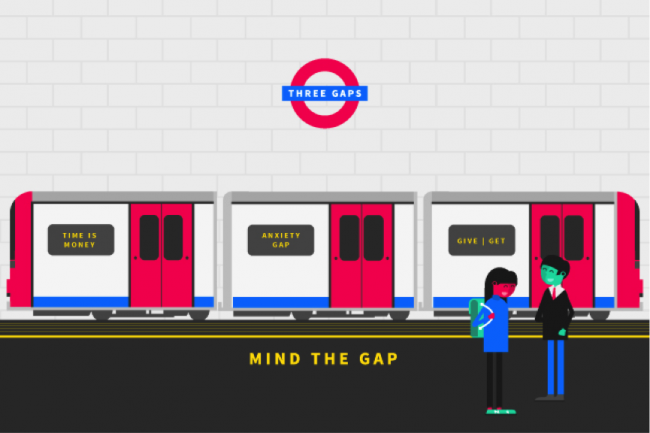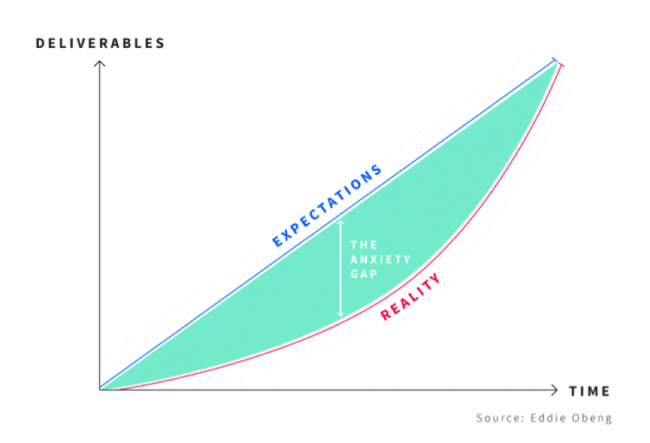Mind the Gap
Corporations and start-ups need each other more than ever. So why are corporate and start-up collaborations so difficult to get right and prone to failure?
Large companies require the creativity and agility that a smaller partner can bring. And smaller companies can benefit from the scale, brand and investment that a larger partner can bring.
We have learned that there are three big gaps in understanding that need to be better managed by both start-ups and corporates for collaborations to be successful.

Challenge 1 – The Time is Money Gap
Firstly, collaborations fail due to a lack of momentum and unclear objectives. Death by a thousand meetings and conference calls. A small company simply cannot survive that long. Before anything has been launched, for a start-up time is most definitely money. Post-launch, building profile and reputation then becomes paramount.
For somebody wanting to work with a start-up within a large company, it’s often the opposite way round. Pre-launch, managing individual and organisational reputations are everything, which can be time consuming. Whereas post-launch, the quarterly reporting machinery kicks in and time becomes money.
Solution: Start at the end and communicate (and stick to) your timescales and decision-making criteria up front. This usually means that a corporate has to move faster than feels comfortable. Make sure there is a pull from the business and you are addressing a critical need not a want. Corporations should expect to pay start-ups for any significant investment of time up front.
Example: In the UBS Future of Finance Challenge, the $300,000 rewards available and all major milestone dates were communicated up front and there was no deviation from the published plan. Applications were received from 52 countries and 60 start-ups were selected to participate who received a stipend that covered their costs and time to participate in the process, in particular a series of regional and global final events, leading to 21 joint ventures as a result.
Challenge 2 – The Anxiety Gap
Secondly, beware of anxiety appearing due to differing expectations on both sides of a collaboration at different times and for different reasons. In most organisations expectations of project deliverables are usually linear. In other words when we are half way through a project most people expect that half of the deliverables will be in place. However this is seldom the case. In fact visible progress almost always lags expectations, with the majority of the deliverables only arriving towards the end.
The difference between progress and expectations is known as the anxiety gap, and is especially important in corporate start-up collaborations.
 Small companies usually experience the anxiety gap early on in the partnership. This is usually due to the effort and risk is not sufficiently proportional to rewards.
Small companies usually experience the anxiety gap early on in the partnership. This is usually due to the effort and risk is not sufficiently proportional to rewards.
On the other hand large companies usually experience the anxiety gap later in the process and shortly before launch of a product, service or programme, when things start to get real and reputations are on the line.
Solution: Anticipate these anxiety gaps and create safe spaces and time to collaborate to work through issues and align expectations. For instance Innovation Airlocks are an example of good practice to help corporates and start-ups share information and align their capabilities and collaboratively develop a proposition whilst protecting intellectual property appropriately through an intermediary facilitator.
Example: Everything Everywhere used an Innovation Airlock with 100%Open as an intermediary to run their Service Innovation Challenge. The airlock started with non-disclosure agreements being signed bother upstream with EE, and downstream with 10 start-ups. There was then an intensive 8-week period where propositions were developed and protected. Finally, there was a pitch session after which had 90 days first right of refusal to enter commercial negotiations with the companies. As a result they found a new start-up partner with whom they developed a new €50m service as a result called EE Tickets.
Challenge 3 – The Give-Get Gap
Collaboration only happens between equals. However most corporate and start-up collaborations have a huge power imbalance in favour of the larger organisation that ultimately undermine any future partnership.
Look for ways to balance the scale and share risk and reward. Long-lasting partnerships are built on a mutually satisfactory balance. So for all corporate and start-up partnerships, both sides should ask what they are going to give and what they are going to get. For a corporate this can mean having to forgoe some short term gain in favour of longer term benefits
Solution: What are we going to give? (e.g. time/resource, license fees, scale, development, test marketing, brand). What are we going to get? (e.g. exclusivity, novel IP, concept development funding, prototyping, branding). Once we have done this for ourselves, we repeat the exercise from our partner’s point of view and note any areas of potential disagreement or imbalance about the value equation and refine.
Example: Ford were looking to innovate new transport solutions through the Mobilize New York challenge for citizens and entrepreneurs. In return they were able to share research data, expertise, support, and development prize funding. And start-ups were able to share creative new solutions in response to the cities challenges and were able to get a platform to showcase and grow their idea in partnership with Ford. The result was over 1000 community members creating 100’s of ideas with 10 finalists showcasing their innovations in the FordHub and sharing $30,000 in prizes and expert mentoring and support.
Summary
Corporate and Start-Up collaborations can often be a U-shaped process. Exciting at the beginning, when there are new ideas for partnerships being developed, and exciting at the end, when there are new projects or products being launched, but generally pretty awful in the middle when there can be mis-aligned expectations and lack of trust. So look for ways to build momentum, create safe spaces to collaborate, and to align expectations to ensure that both sides of the collaboration can benefit from each other’s strengths and capabilities, and thereby create new profitable partnerships.
______________
This post was originally published on the blog of the excellent new initiative Touchpaper.org – a free toolkit to help make corporate and startup relationships flourish.